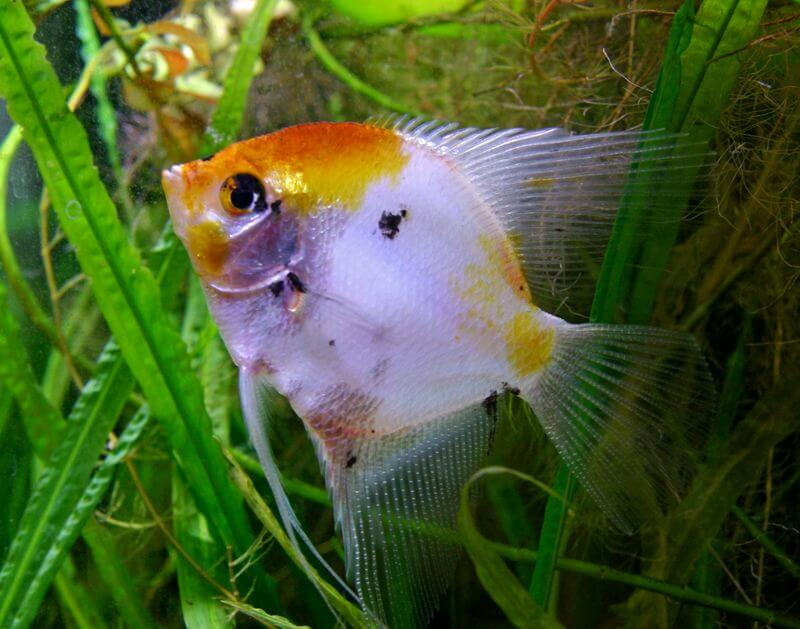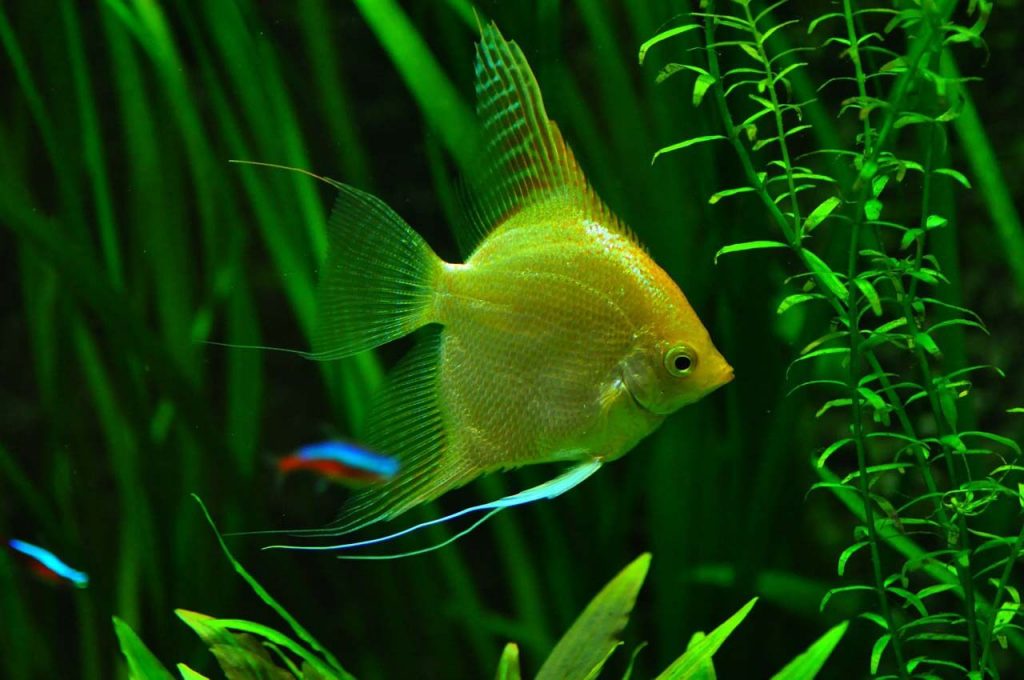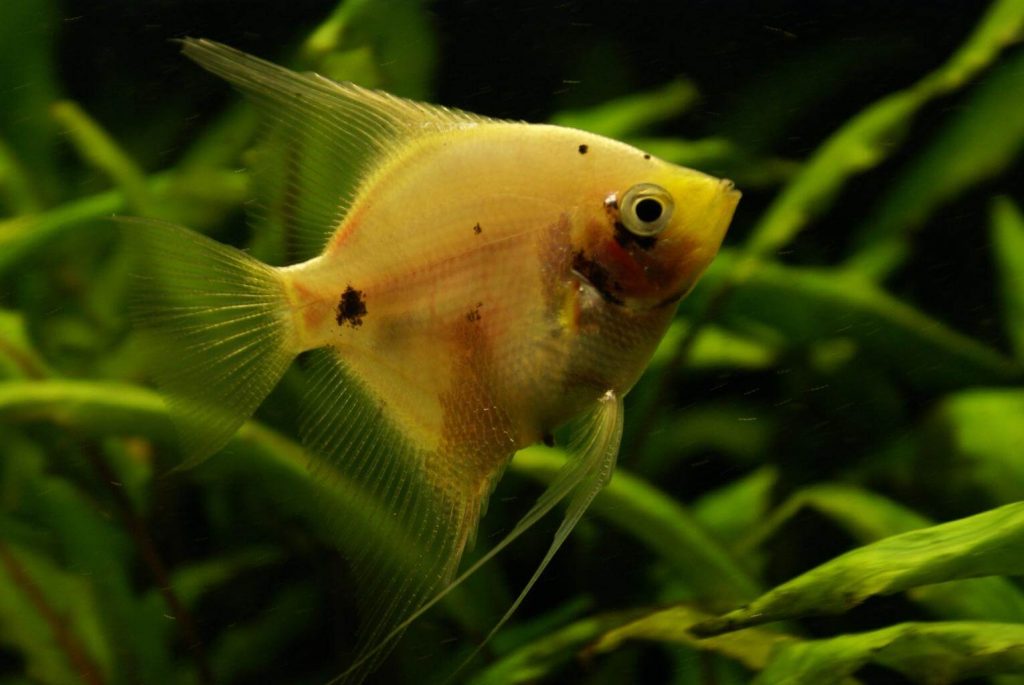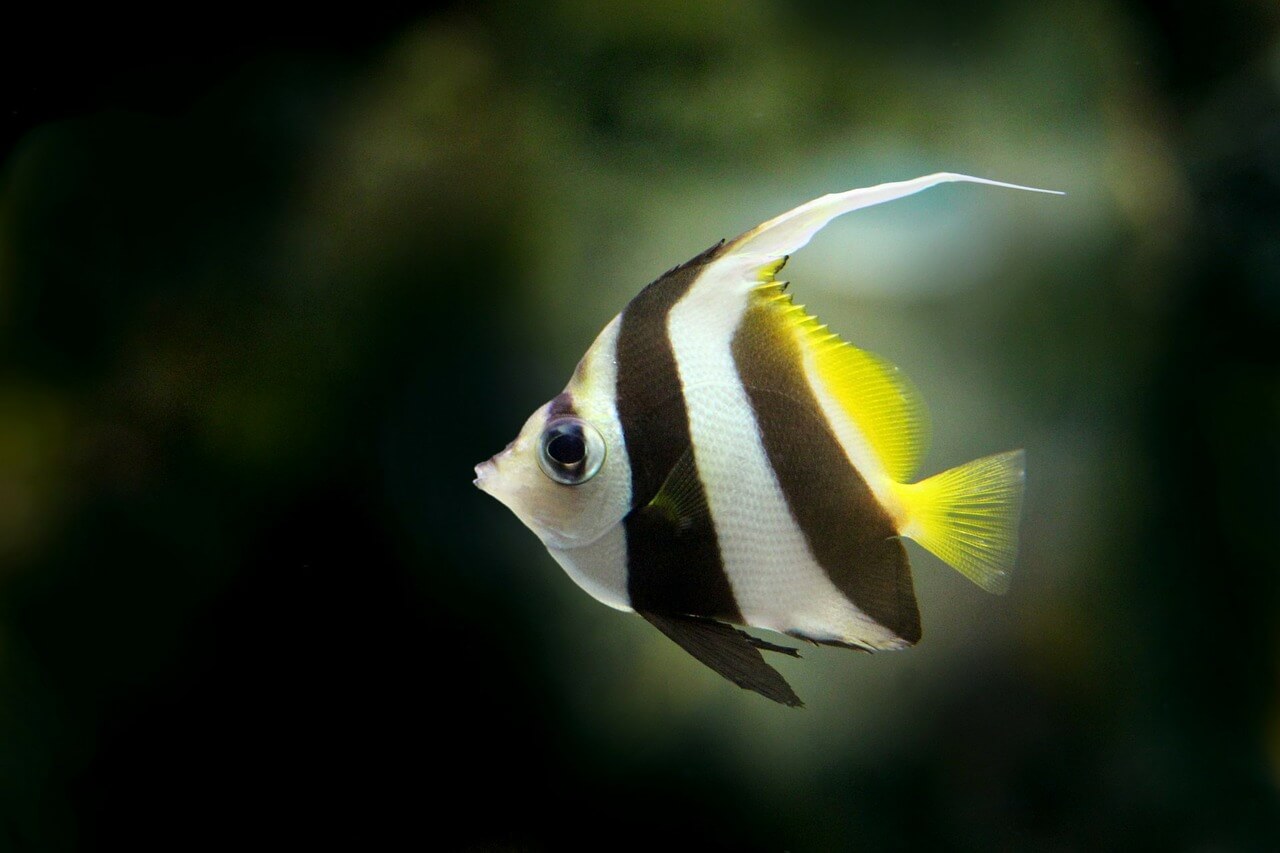If you are a fish aficionado, you would know that angelfish is one of the most striking marine species in the world. But there is also a freshwater variant of this fish that you could introduce in your freshwater aquarium!
Known as an Angelfish due to their unique wing-shaped fins, the Freshwater Angelfish is native to South America. In fact, they are actually part of the Cichlid family.
Aquarists who have experience with other types of Cichlids would do just fine with the Angelfish. But to make sure, here are some of our top tips on their care, maintenance, feeding, and breeding.
| Category | Rating |
| Scientific Name: | Pterophyllum scalare |
| Common Names: | Angelfish, scalare, leaf fish |
| Care Level: | Easy (Beginner friendly) |
| Temperament: | Tendency for aggression |
| Size: | Up to 6 inches |
| Color: | Gold, black, silver, and marble |
| Life Expectancy: | Up to 10 years |
| Diet: | Omnivore |
| Family: | Cichlidae |
| Tank Size: | Minimum 20 Gallons |
| Tank Setup: | Requires fine sands/ substrate |
Table of Contents
Overview

It has the scientific name Pterophyllum scalare and is considered as a family of Cichlidae, which includes other species of freshwater Cichlids. With that said, note that this is different from the Marine Angelfish, a saltwater species belonging to the Pomacanthidae family.
Our freshwater type of fish can naturally be found in the Amazon River. They also roam its various tributaries such as the ones in Peru and Colombia. This species is well-beloved by many hobbyists due to its easy maintenance and beautiful appearance.
Additionally, they are also much less aggressive than other Cichlids. You can expect the Angelfish to live 10 years if you keep them healthy in well-cared tanks, with maturity being reached at only 10 months old.
It is relatively easy to buy these fishes in any aquarium store for roughly $10. However, the specialty breeds may cost up to $40 for the higher quality and more unique types.
Typical Behavior
While they may be more peaceful than most other Cichlids, there is still a natural tendency for aggression. This is why you should be careful! Angelfishes may form hierarchies and get into fights for these “positions”.
They may swim in tiny schools without socializing much with one another, while also being territorial. The good news is they are still quite tolerant and will not intimidate other fish outside of their own school.
While they will not swim in fancy patterns and forage together with their own, you can expect some form of active swimming. They are quite showy, although they prefer to hide when the tank is crowded.
Moreover, the Angelfish is considered the rare type that actually looks after their children! They will defend their eggs and young fry for the first two months of their lives, which might provide some affable entertainment in your tank.
Appearance and Types of Freshwater Angelfish
One of the most unique things about them is their tall and graceful fins. While their body may measure only around 6 inches, their fins can grow up to 8 inches! Pretty impressive, right?
These fins consist of trailing dorsal and pectoral fins, while the caudal fin is shaped like a majestic fan that sweeps along as they swim. Meanwhile, they have triangular snouts and arrow-like bodies.
Most freshwater Angelfishes are born silver with 7 black stripes, which disappear to just 4 as they grow larger. You can also find other colors of gold, black, and marbled. The last variety has irregular black bands instead of bold straight ones.
If you are interested in making your tank as colorful as possible, you might love the specialty Angelfish. These are ones bred to display unique colors, including the Goldfish or Panda variety.
Freshwater Angelfish Care Guide
Moving on to how you can care for your new fish, know that they are common carriers of nematodes. These parasites often cause lethal diseases that can spread in the tank. You can provide infection by ensuring the aquarium is always clean and free from excess food.
Nematodes will inhibit their hosts and steal their nutrition, rendering your fish sickly and weak. You may notice inflammation or bleeding in infected fishes. The best thing to do now is to separate them! It is also possible to treat this with a dewormer, which we recommend getting from a certified veterinarian.
Additionally, you might want to watch out for the equally parasitical Hexamita. It often attacks Cichlids and can cause symptoms like weight loss, sluggishness, and even discoloration.
Preventing these infections can be done by regularly cleaning the tank. Make sure not to feed them wildly caught live foods, and always quarantine new fish before adding them. This aside, you should be able to keep your Angelfish healthy.
Tank Setup & Habitat Preparation

In terms of setting up the tank to be as comfortable for your Freshwater Angelfish as possible, strive to mimic the natural habitat of the Amazon River. These are slow-moving rivers and floodplains.
The substrate has to be made up of fine sands as they enjoy digging through them. You would not want them to injure their fins with sharp rocks and rough edges. We recommend mud as well.
The tank should also have plenty of aquatic plants and mosses where they can hide. Ideally, these would be plants you can find in the Amazon, like Amazon Sword plants or Anacharis. Java Fern and Java Moss are great options too, but we advise against using floating vegetation that can overcrowd the environment.
Furthermore, they are used to weak water flows, so you do not have to create a powerful stream in the tank. Low-flow aeration is probably best. For light exposure, try to keep the tank well illuminated for around 8-12 hours each day.
Water Parameters
Considering the Angelfish are a tropical species, they thrive in warmer waters that are around 75 and 82°F, and slightly acidic at a pH of 6.8 to 7.
They also naturally live in clear waters and swim near the bottom, but where light can still shine through. It can be worthwhile ensuring they have enough light so they can feel right at home in their new tank.
Recommended Tank Size
A pair of this species can survive with at least 20 gallons of water, while 80 gallons is the bare minimum for a small school of Angelfishes.
The rule of thumb is 10 gallons for each fish that you add to the aquarium. Avoid overcrowding and adding too many species, plants, or décor in one tank. This will unnerve your fishes and limit their swimming space.
Feeding Your Angelfish
What about food? Although the Angelfish are omnivorous, they eat mostly live prey in the wild. This includes anything from insects and crustaceans to larvae and other small fish. As a result, it is recommended to feed them a high-protein and high-fiber diet.
They may eat plants or algae from time to time for fiber, but not often. You can try supplementing their diet with occasional cooked vegetables, such as zucchini and spinach.
We recommend feeding them live foods such as tubifex worms, which contain important protein for them. Water fleas and brine shrimp are also good.
At the same time, you can always mix up their diet with pellet or flake foods. Just make sure these are high protein as well. Other options can be frozen glass worms or krill.
Angelfishes eat a lot, so you must feed them at least twice every day. Mates who are about to be bred will eat 4 times!
Freshwater Angelfish Tank Mates
The Amazon basin is very diverse. In fact, wild Angelfish are used to live along with other fish species, although choosing their tank mates may prove a little tricky.
You can keep them with other Cichlids but only those that are not easily bullied. For example, Dwarf Cichlid, Discus, and Bolivian Ram can be great tank mates for an Angelfish. Jack Dempseys can live with them too.
However, you should not keep Oscars and Convicts, both of which are more aggressive, with them. Nor should you introduce an Angelfish to the home of Barbs.
Besides that, you might want to consider housing your Angelfish with Mollies, small Catfish, or Dwarf Gouramis. In terms of non-fish tank mates, they will pretty much always fall prey to this fish, especially small crustaceans and weaker invertebrates.
Can You Keep Multiple Angelfishes Together?
While you know some species that would be compatible with Angelfish, experienced aquarium owners still recommend keeping them in a single species tank. You can keep them in groups of 5 or 6.
This small number will trigger them to form hierarchies and display a moderate amount of competition. Indeed, this is a good thing for your tank!
On the other hand, you should not be mixing multiple species of Angelfish. There is a huge possibility that they will be more territorial and aggressive as they fight for dominance over space.
Breeding
Moving on to breeding, you might be excited to know that this species can be bred easily at home. They will even mate naturally when in small schools. All you need to do is spot which fishes have paired and mated, then prepare the breeding ground.
The breeding tank should be 20 gallons and has a low flowing filter, as well as a slanted surface. It should be warmer than usual, at 82°F in water temperature. You can make spawning areas using tiles, pipes, and some Anacharis. Feed both fishes with high-protein foods around 4 times per day.
You can check if the female is ready to lay eggs when she swims near the spawning surface. Each spawn may produce around 200 to 400 eggs, which the male will then fertilize.
As we have said earlier, Angelfish are familial and will take care of their fry. Let them be for a month before separating the young fish into a rearing tank of around 20 gallons in size.
For the first 7 weeks, feed them with brine shrimp larvae or mashed-up boiled eggs. Only then you can start providing flake foods. These tiny Angelfish should be ready to migrate into a general tank once they hit 8 weeks of age.
Should You Get Angelfish for your Freshwater Aquarium?

The most important question of the day remains: should you get Angelfish for your freshwater aquarium? Known by some aquarists as the ‘King of the Aquarium’, it is easy to understand why these beautiful and spectacular fish are so popular.
They will thrive in a single species tank and interact within their school. However, they will also provide a little bit of majesty in a community tank. With a variety of entrancing colors and patterns, you can choose any Angelfish and they will look just as pretty.
It is definitely useful if you have had experience with other Cichlids or other tropical freshwater species. With that said, there is no reason why beginning hobbyists cannot keep them well and alive!
We would say that this exotic fish is quite beginner-friendly, as long as you pay enough care and attention. With all its grace, beauty, and charm, why not get an Angelfish to make your home aquarium shine a little more?






